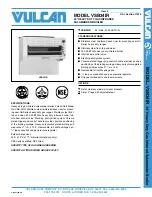
42
First couple of cold starts may be rough due to gas line not
being completely purged of air, causing low
fi
ring rate and
high excess air levels.
Inspect Venting And Air Intake System
Operate boiler and verify all vent/air intake connections are
gas-tight and watertight. Repair any leaks immediately.
Inspect Condensate Drain
Verify all connections are watertight, and that condensate
fl
ows freely. Repair any leaks immediately.
Inspect System Piping
Verify all connections are watertight. Repair any leaks
immediately.
VERIFICATION PROCEDURE AND ADJUSTMENT
Verify Proper Sequence Of Operation
Place boiler into operation and observe operation through
several cycles. Follow remaining steps in this section to
insure boiler is operating correctly.
Test High Limit Control And Adjust
While burner is operating,adjust high limit setpoint below
actual boiler water temperature. Burner should go off while
circulator continues to operate. Raise limit setting above
boiler water temperature and burner should reignite after
inter-purge (retry delay). Set high limit control to design
temperature requirements of system. Maximum high limit
setting is 190°F. Minimum high limit setting is 100°F.
Test Other Safety Controls
If boiler is equipped with low water cut off, manual reset
high limit, or additional safety controls, test for operation
as outlined by control manufacturer. Burner should be
operating and should go off when controls are tested. When
safety controls are restored, burner should reignite.
Set Thermostat Heat Anticipator (If Used) And
Verify Thermostat Operation
For single thermostat connected to yellow thermostat lead
wires in furnished
fi
eld wiring junction box, heat anticipator
should be set at 0.7 amps. For other wiring con
fi
gurations,
refer to instructions provided by thermostat manufacturer
regarding adjustment of heat anticipator. Cycle boiler
with thermostat. Raise thermostat to highest setting and
verify boiler goes through normal start up cycle. Lower
thermostat to lowest setting and verify boiler goes off.
Measure Natural Gas Input Rate
Correct input rate is essential for proper and ef
fi
cient
operation of the burner and boiler.
1.
Determine elevation at installation site.
2.
Table 1 and Table 2, Page 6
to determine correct input
rate for the local elevation.
3.
Obtain yearly average heating value of local gas supply
from gas utility. At sea level elevation, it should be
approximately 1000 Btu’s per standard cubic foot.
4.
Operate boiler for 5 minutes.
5.
Turn off all other gas appliances, extinguishing standing
pilots where applicable.
6.
At gas meter, measure time in seconds required to use
one cubic foot of gas.
7.
Calculate input rate according to the following formula:
3600 x heating value from step 3
Btuh in put rate = time from step 6
8.
Measured input rate should be /-2% of input
rating from step 2. If within 2%, go to step 9. If not,
adjustment is required, proceed as follows:
A. Turn boiler off
B. Set up U-tube manometer or differential pressure
gauge for measuring manifold pressure. See
Figure 25, Page 44 .
C. Manometer or gauge must be able to read at least
0.0 to 3.0 inches water column of pressure, and
resolve to at least 0.1 inches water column.
D. Turn boiler on.
E. Manifold pressure has been nominally set at 2.5
inches w.c. Manifold pressure and input rate must
always be measured with pressure regulator cover
screw installed. Cover screw must be removed for
adjustment. Manifold pressure reading will change
(increase) when cover screw is removed.
F. After adjusting input rate, turn boiler off, remove
manometer or pressure gauge, reinstall
⅛
” plug
on gas valve. Turn boiler on.
G. Boiler should typically operate between:
• 8.5% -10.0% CO2 on Natural Gas
• 9.5% -11.0% CO2 on Propane Gas
Under all conditions CO level should not exceed 100
ppm.
9.
Restore all gas appliances that may have been shut off
(while measuring boiler input rate) to normal operating
conditions.
I. Remove regulator cover screw on top of gas valve,
and insert an appropriate screwdriver into adjustment
screw.
II. Turn adjustment screw clockwise to increase input
rate, or counter clockwise to decrease input rate.
III. Replace cover screw, or cover hole temporarily with
your
fi
nger to check new manifold pressure setting. Do
not set manifold pressure lower than 2.0 inches w.c.
or higher than 3.0 inches w.c. when adjusting input
rate.
Summary of Contents for UB90-100
Page 33: ...33 Figure 22 Ladder Diagram for Figure 22 ELECTRICAL WIRING ...
Page 52: ...52 Troubleshooting Chart 1 TROUBLESHOOTING ...
Page 53: ...53 Troubleshooting Chart 2 TROUBLESHOOTING ...
Page 63: ...NOTES ...
Page 64: ...UTICA BOILERS 2201 Dwyer Avenue Utica NY 13501 web site www ecrinternational com ...
















































